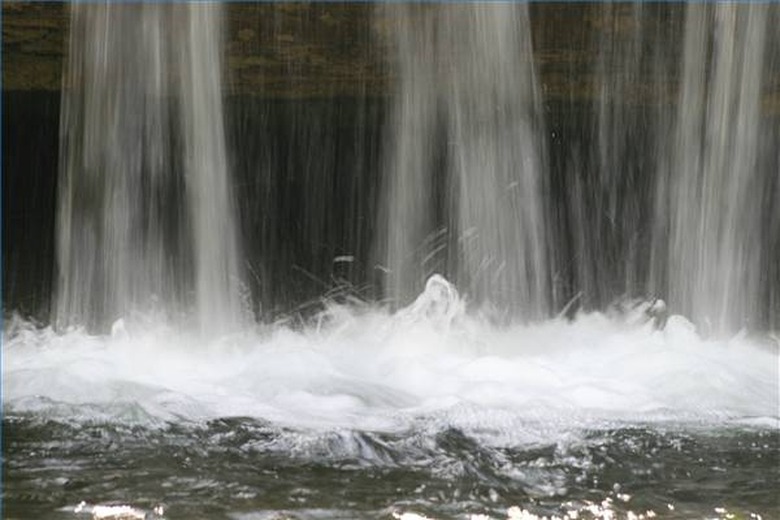What Kinds Of Things Pollute Water?
Few images evoke a sense of purity like fresh, clear-running water. And with up to 60 percent of an adult human body being made of water, few substances are more important to human life. But certain industrial failures – from contaminated factory waste to improper sewage treatment – can pollute water. People often unwittingly contribute to pollution too; phosphate-laden detergents, leaking motors, and the use of some fertilizers and pesticides are just three ways in which people pollute water without realizing it.
Bacteria and Parasites from Sewage
Bacteria and Parasites from Sewage
If sewage is improperly treated, it can contaminate water with a variety of bacteria and other parasites. Contaminants from sewage include cryptosporidium, salmonella, giardia and parasitic worms. This kind of contamination is more commonly a problem in less-developed countries but can happen in developed countries, causing illness in those who drink the contaminated water. For instance, thousands of residents of a community in Georgia became ill from a cryptosporidium contamination of the water supply in 1987.
Industrial Waste
Industrial Waste
Manufacturing plants are supposed to treat wastewater before discharging it into the surrounding water, but some industrial waste can still make it into the water supply. Common industrial contaminants include sulfur dioxide and other acids, heavy metals and industrial solvents. Iron and steel production and mining operations can also pollute water with ammonia, cyanide and arsenic.
Fertilizer and Lawn Chemicals
Fertilizer and Lawn Chemicals
Fertilizers and pesticides from agricultural lands and chemicals used on lawns in residential areas contaminate the groundwater and nearby lakes and rivers. When rain washes over farms or yards treated with these chemicals, pesticides and nutrients from the fertilizers flow into the water supply. When a body of water becomes too enriched with certain nutrients from manure and fertilizer, it encourages algae blooms. These blooms block sunlight from underwater plants, reducing the oxygen in the lake water and threatening wildlife that live in or near the body of water.
Silt and Soil
Silt and Soil
Lakes and other bodies of water naturally undergo changes as rivers and rainstorms wash silt and soil into them. However, humans can speed up the process through agricultural practices and through urban development that erodes the banks of rivers and lakes. As the silt and soil build up in the lake, they encourage new kinds of plant and animal populations to grow and others to decrease. The process often robs the body of water of oxygen that living things need. As silt and soil are deposited, the bottom of the body of water is built up and the lake or pond gradually becomes shallower, adding to the change in the aquatic ecosystem.
Humans and Water Pollution Through Detergents
Humans and Water Pollution Through Detergents
Though wastewater is treated before being discharged, small amounts of detergents still end up in the water supply, contaminating it with phosphates. Phosphates from detergents, like nutrients from fertilizers, contribute to the growth of algae. This can affect the oxygen levels in bodies of water and harm plant and animals living in the body of water. Today, many detergents low in phosphates are available for purchase.
Petrochemicals Contribute to Water Pollution
Petrochemicals Contribute to Water Pollution
Gasoline, oil and other petrochemicals also contribute to water pollution. This can occur on a large scale when an oil tanker springs a leak, as in the Exxon Valdez tanker spill off the coast of Alaska in 1989. On a smaller scale, other things that can pollute water include oil and gas leaking from the motor of a boat on a lake or when rain washes oil drips from a driveway into groundwater. Maintaining vehicles and catching and repairing drips and leaks early can minimize this kind of pollution.
Cite This Article
MLA
Rigg, Sarah. "What Kinds Of Things Pollute Water?" sciencing.com, https://www.sciencing.com/kinds-things-pollute-water-5059524/. 22 November 2019.
APA
Rigg, Sarah. (2019, November 22). What Kinds Of Things Pollute Water?. sciencing.com. Retrieved from https://www.sciencing.com/kinds-things-pollute-water-5059524/
Chicago
Rigg, Sarah. What Kinds Of Things Pollute Water? last modified March 24, 2022. https://www.sciencing.com/kinds-things-pollute-water-5059524/
